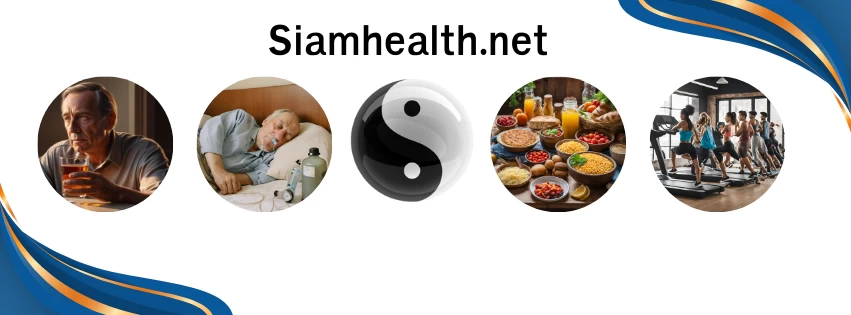
หน้าหลัก | สุขภาพดี | สุภาพสตรี | การแปลผลเลือด | โรคต่างๆ | วัคซีน | อาหารเพื่อสุขภาพ
การดื่มหนัก Binge Drinking: ภัยเงียบที่ทำลายสุขภาพ
ผลกระทบของการดื่มแอลกอฮอล์แบบ "Binge Drinking"
การดื่มแบบ Binge Drinking หรือที่เรียกกันว่า "การดื่มหนักเป็นครั้งคราว" กำลังเป็นปัญหาที่พบได้บ่อยขึ้นในสังคมไทย โดยเฉพาะในกลุ่มวัยรุ่นและวัยหนุ่มสาว ซึ่งมักเกิดขึ้นในงานสังสรรค์ ปาร์ตี้ หรือสถานบันเทิงต่าง ๆ Binge Drinking คือพฤติกรรมการดื่มเครื่องดื่มแอลกอฮอล์ในปริมาณมาก ๆ ภายในระยะเวลาอันสั้น แต่มีรูปแบบการดื่มที่มีความเสี่ยงสูงมากขึ้นที่เรียกว่า "Binge Drinking" หรือการดื่มอย่างรวดเร็วและมากในเวลาอันสั้น การดื่มในลักษณะนี้อาจส่งผลเสียต่อร่างกายและจิตใจเป็นอย่างมาก และยังสร้างปัญหาต่อสังคมในหลายแง่มุม

ความหมายของ Binge Drinking
Binge Drinking หมายถึง การดื่มแอลกอฮอล์จำนวนมากในระยะเวลาอันสั้น โดยทั่วไปคือการดื่มอย่างน้อย 5 แก้วสำหรับผู้ชาย และ 4 แก้วสำหรับผู้หญิงในเวลาไม่เกิน 2 ชั่วโมง การดื่มในลักษณะนี้สามารถเพิ่มระดับแอลกอฮอล์ในเลือดให้สูงเกินกว่าค่าปลอดภัย และอาจทำให้เกิดผลข้างเคียงที่รุนแรงได้
ผลกระทบระยะสั้นของ Binge Drinking
-
ผลกระทบต่อการตัดสินใจ: เมื่อระดับแอลกอฮอล์ในเลือดสูงขึ้น สมองจะได้รับผลกระทบที่ทำให้การตัดสินใจลดลง ทำให้มีโอกาสตัดสินใจในสิ่งที่ไม่ปลอดภัยได้ง่ายขึ้น เช่น การขับขี่ยานพาหนะหรือการกระทำที่เสี่ยงอันตรายอื่น ๆ
-
อุบัติเหตุและการบาดเจ็บ: การดื่ม Binge Drinking ทำให้สูญเสียความสามารถในการควบคุมร่างกายและการตอบสนอง ส่งผลให้มีความเสี่ยงต่ออุบัติเหตุและการบาดเจ็บได้มากขึ้น โดยเฉพาะอุบัติเหตุทางถนน การตกจากที่สูง หรือการทะเลาะวิวาท
-
พิษจากแอลกอฮอล์: ในกรณีที่มีการดื่มมากเกินไป ร่างกายอาจไม่สามารถเผาผลาญแอลกอฮอล์ได้ทัน ทำให้ระดับแอลกอฮอล์ในเลือดสูงขึ้นอย่างรวดเร็ว ซึ่งอาจนำไปสู่การเป็นพิษจากแอลกอฮอล์ (Alcohol Poisoning) และมีความเสี่ยงต่อการเสียชีวิต
ผลกระทบระยะยาวของ Binge Drinking
-
ความเสี่ยงต่อสุขภาพจิต: การดื่มแอลกอฮอล์ในปริมาณมากบ่อยครั้งอาจทำให้เกิดความเสี่ยงในการเกิดโรคซึมเศร้า วิตกกังวล หรืออาการเสพติดแอลกอฮอล์
-
โรคเกี่ยวกับตับ: Binge Drinking เพิ่มความเสี่ยงในการเกิดโรคตับ โดยเฉพาะโรคตับอักเสบ ตับแข็ง และโรคมะเร็งตับ นอกจากนี้ยังอาจส่งผลต่อการทำงานของอวัยวะอื่น ๆ เช่น หัวใจ และระบบภูมิคุ้มกัน
-
ปัญหาในการสร้างความสัมพันธ์: การดื่มแอลกอฮอล์มากเกินไปส่งผลให้ผู้ดื่มมีพฤติกรรมก้าวร้าวและไม่สนใจต่อความรู้สึกของผู้อื่น จึงมีโอกาสทำลายความสัมพันธ์ที่ดีในครอบครัวและเพื่อนฝูง
ปัจจัยเสี่ยง
มีปัจจัยหลายอย่างที่ส่งผลให้คนหันมาดื่มแบบ Binge Drinking เช่น
- ปัจจัยด้านสังคมและวัฒนธรรม: การยอมรับการดื่มแอลกอฮอล์ในสังคม การเข้าถึงเครื่องดื่มแอลกอฮอล์ได้ง่าย รวมถึงอิทธิพลจากเพื่อน
- ปัจจัยด้านจิตใจ: ความเครียด ความวิตกกังวล ภาวะซึมเศร้า
- ปัจจัยด้านชีวภาพ: พันธุกรรม เพศ และอาย
การป้องกันและการแก้ไข
-
การให้ความรู้เกี่ยวกับความเสี่ยง: การให้ความรู้และความเข้าใจในผลกระทบของ Binge Drinking สามารถช่วยลดการดื่มในกลุ่มวัยรุ่นและวัยทำงานได้
-
การส่งเสริมกิจกรรมที่ดีต่อสุขภาพ: การมีกิจกรรมอื่น ๆ ที่สามารถแทนที่การดื่มแอลกอฮอล์ในช่วงเวลาว่าง เช่น การออกกำลังกาย หรือการทำงานอาสา จะช่วยลดโอกาสที่ผู้คนจะหันไปพึ่งแอลกอฮอล์
-
การสนับสนุนด้านจิตใจ: สำหรับผู้ที่มีปัญหาด้านจิตใจหรือความเครียด การมีการบำบัดและสนับสนุนทางด้านจิตใจจะช่วยลดความต้องการในการดื่มแอลกอฮอล์
- การควบคุมการเข้าถึงแอลกอฮอล์: จำกัดเวลาและสถานที่ในการขาย ควบคุมราคา และจำกัดการโฆษณา
- การสนับสนุนจากครอบครัวและชุมชน: สร้างสภาพแวดล้อมที่เอื้อต่อการไม่ดื่ม ส่งเสริมกิจกรรมทางเลือก และให้การสนับสนุนผู้ที่มีปัญหา
สรุป
การดื่มแอลกอฮอล์ในลักษณะ Binge Drinking เป็นพฤติกรรมที่มีความเสี่ยงสูงและมีผลกระทบอย่างร้ายแรงทั้งในระยะสั้นและระยะยาว การป้องกันพฤติกรรมการดื่มที่ไม่เหมาะสมและการให้ความรู้ความเข้าใจเกี่ยวกับผลเสียของ Binge Drinking จึงมีความสำคัญอย่างยิ่ง
ทบทวนวันที่
โดย นายแพทย์ ประพันธ์ ปลื้มภาณุภัทร อายุรแพทย์,แพทย์เวชศาสตร์ครอบครัว

